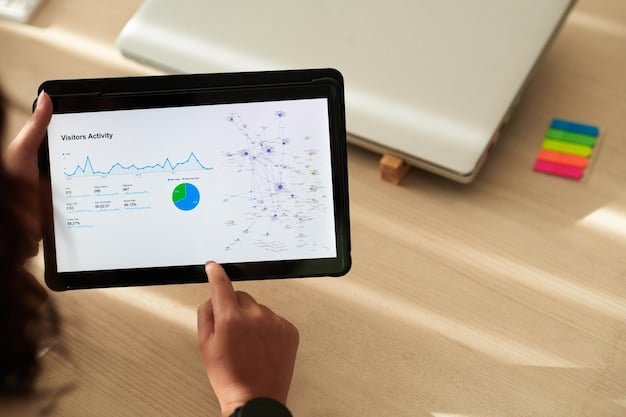Social Media Analytics: Boosting News Engagement and Reach

Anúncios
Social media analytics provide invaluable insights for online news platforms to understand audience behavior, optimize content strategies, and ultimately improve engagement and reach in a data-driven manner.
Anúncios
Want to make your online news content go further and grab more attention? Then it’s time to dive into how to use social media analytics to improve engagement and reach for online news content. Social media platforms are treasure troves of data, offering insights that can transform how news is created, shared, and consumed. Let’s explore how to harness this power.
Understanding the Basics of Social Media Analytics
Social media analytics is more than just counting likes and shares. It is the process of gathering and analyzing data from social media platforms to understand audience behavior and the performance of your content. This insight is invaluable for any online news outlet looking to enhance its impact.
Anúncios
By tracking key metrics and understanding audience preferences, you can make informed decisions on content strategy, timing, and platform choice.
Key Metrics to Track
Knowing what to measure is the first step. Some key metrics include engagement rate (likes, shares, comments), reach (number of unique users who saw the content), impressions (total number of times the content was displayed), and click-through rate (CTR).
- Engagement Rate: Measures how actively involved your audience is with your content.
- Reach: Indicates the potential audience size your content could reach.
- Impressions: Shows how often your content is displayed, regardless of clicks or engagement.
- Click-Through Rate (CTR): Reflects the percentage of viewers who click on a link in your post.
These metrics provide a snapshot of your social media performance, helping you understand what’s working and what’s not.
Tools for Social Media Analytics
Various tools can assist in social media analytics. Platform-native tools like Facebook Insights and Twitter Analytics are a good starting point. For more advanced analysis and cross-platform insights, consider third-party tools like Hootsuite Analytics, Buffer Analyze, or Sprout Social.

These tools offer in-depth analysis, custom reporting, and the ability to track competitors, helping you stay ahead of the curve.
In essence, grasping the basics of social media analytics empowers online news platforms to make data-driven decisions, leading to more effective content strategies and increased audience engagement.
Identifying Your Target Audience
Knowing your audience is crucial for crafting relevant and engaging news content. Social media analytics can reveal valuable demographic and psychographic information, helping you tailor your news to resonate with specific groups.
Understanding your audience’s interests, preferences, and online behavior allows you to refine your content strategy and deliver news that matters to them.
Demographic Data
Demographic data includes age, gender, location, education, and occupation. Understanding these characteristics helps you create content that speaks directly to your core audience.
For example, if you find that a significant portion of your audience is young adults, you might focus on topics relevant to their interests, such as technology, social issues, or entertainment.
Psychographic Data
Psychographic data delves into your audience’s values, interests, lifestyles, and attitudes. This insight helps you understand their motivations and preferences, allowing you to create content that resonates on a deeper level.
- Values: What principles and beliefs are important to your audience?
- Interests: What topics and activities do they enjoy?
- Lifestyles: How do they spend their time and money?
- Attitudes: What are their opinions on various issues?
For instance, if your audience values environmental conservation, you might feature news stories about sustainability, climate change, and eco-friendly initiatives.
By combining demographic and psychographic data, you can create detailed audience personas that guide your content creation and distribution efforts.
Successfully identifying your target audience is a cornerstone of effective content strategy, enabling you to deliver news that captivates and retains readers.
Crafting Engaging News Content
Engaging news content is crucial for capturing and retaining audience attention on social media. Understanding what makes content compelling can significantly improve reach and impact.
Focus on creating content that is informative, visually appealing, and tailored to your audience’s interests.
Visual Storytelling
Visuals are incredibly powerful on social media. Use images, videos, infographics, and GIFs to enhance your news stories and make them more engaging. High-quality visuals can capture attention and convey information quickly and effectively.
Videos, in particular, are highly effective in driving engagement. Consider creating short news updates, interviews, or behind-the-scenes glimpses to connect with your audience on a personal level.
Interactive Content
Interactive content encourages audience participation and can significantly boost engagement. Polls, quizzes, surveys, and Q&A sessions invite your audience to share their opinions and engage with your news content in a meaningful way.
- Polls: Gather quick opinions on current events.
- Quizzes: Test your audience’s knowledge of news topics.
- Surveys: Collect feedback on your news coverage.
- Q&A Sessions: Answer audience questions in real-time.
Make sure your interactive content is relevant, easy to participate in, and provides value to your audience.

By incorporating visual storytelling and interactive elements, you can create news content that captivates your audience, drives engagement, and extends your reach on social media.
Optimizing Posting Schedules
Timing is everything when it comes to social media. Posting at the right time can significantly increase the visibility and engagement of your news content.
Social media analytics can help you identify when your audience is most active and receptive to your content.
Analyzing Peak Activity Times
Most social media analytics tools provide data on when your audience is most active. Analyze these insights to identify peak posting times for each platform.
Consider factors such as time zones, work schedules, and typical online behavior when determining the best times to post.
Platform-Specific Strategies
Different platforms have different optimal posting times. What works on Facebook may not work on Twitter or Instagram. Tailor your posting schedule to each platform’s unique dynamics.
- Facebook: Often sees higher engagement during midday and early afternoons.
- Twitter: Is more effective during weekdays, especially during commute times.
- Instagram: Performs well during lunchtime and evenings.
Experiment with different posting times and track the results to continuously refine your strategy.
By strategically optimizing your posting schedule, you can ensure that your news content reaches the largest possible audience and maximizes engagement.
Leveraging Platform Features
Each social media platform offers unique features that can enhance your news content and expand your reach. Understanding and leveraging these features is essential for maximizing your social media impact.
Explore the various tools, formats, and functionalities available on each platform to create compelling and shareable news content.
Utilizing Hashtags
Hashtags are a powerful tool for increasing the visibility of your news content. Use relevant and trending hashtags to reach a wider audience and connect with specific communities.
Research popular hashtags in your niche and incorporate them strategically into your posts. Avoid using too many hashtags, as it can make your content appear spammy. Aim for a mix of broad and specific hashtags to maximize reach.
Engaging with Comments and Messages
Responding to comments and messages is crucial for building relationships with your audience and fostering a sense of community. Monitor your social media channels regularly and engage with your followers in a timely and thoughtful manner.
Address questions, respond to feedback, and participate in conversations to show that you value your audience’s input and are committed to providing valuable and engaging news content.
Exploring New Formats
Platforms are constantly introducing new formats and features, from Stories and Reels to live video and audio rooms. Experiment with these formats to discover new ways to engage your audience and reach new users.
- Stories: Share quick updates, behind-the-scenes glimpses, and interactive polls.
- Reels: Create short, entertaining videos that capture attention and go viral.
- Live Video: Host live Q&A sessions, interviews, or news updates.
By continuously exploring and leveraging platform features, you can keep your social media strategy fresh, engaging, and effective.
Measuring and Refining Your Strategy
Social media analytics is an ongoing process of measuring, analyzing, and refining your strategy. Regularly evaluate your performance, identify areas for improvement, and adapt your approach to stay ahead of the curve.
Use data-driven insights to make informed decisions about content creation, distribution, and engagement.
Tracking Key Performance Indicators (KPIs)
Establish key performance indicators (KPIs) to track your progress and measure the success of your social media efforts. KPIs might include:
Engagement rate, reach, website traffic, lead generation, and brand awareness. Monitor these metrics regularly and compare them to your goals.
A/B Testing
A/B testing involves experimenting with different versions of your content to see which performs better. Test different headlines, visuals, posting times, and formats to optimize your social media strategy.
Staying Updated
Social media is constantly evolving, so it’s essential to stay updated on the latest trends, best practices, and algorithm changes. Follow industry blogs, attend webinars, and join online communities to stay informed and adapt your strategy accordingly.
By continuously measuring and refining your social media strategy, you can ensure that your news content remains relevant, engaging, and impactful.
| Key Point | Brief Description |
|---|---|
| 📊 Analytics Basics | Understand key metrics like engagement, reach, and CTR to gauge content performance. |
| 🎯 Target Audience | Identify demographic and psychographic traits for tailored content creation. |
| ✨ Engaging Content | Incorporate visuals and interactive elements to boost audience involvement. |
| ⏰ Optimize Schedules | Post at peak activity times to maximize visibility and engagement. |
What are the primary benefits of using social media analytics for online news?
▼
Social media analytics helps online news outlets understand audience preferences, optimize content strategies, and improve engagement and reach. It enables data-driven decisions that enhance news relevance and impact.
▼
Social media analytics provides demographic and psychographic data about your audience, including age, gender, location, interests, and values. This information helps you tailor content to resonate with specific groups.
▼
Visual content like images and videos, as well as interactive content such as polls and quizzes, tend to be highly engaging. Content that is informative, timely, and relevant to your audience also performs well.
▼
Social media analytics tools provide data on when your audience is most active. Analyze this information to identify peak posting times for each platform and schedule your content accordingly.
▼
Establish key performance indicators (KPIs) such as engagement rate, reach, website traffic, and brand awareness. Track these metrics regularly and use the data to refine your strategy and improve results.
Conclusion
By embracing the power of social media analytics, online news platforms can unlock valuable insights, refine their content strategies, and cultivate deeper connections with their audiences. The journey towards enhanced engagement and reach begins with data, and the possibilities are endless.





